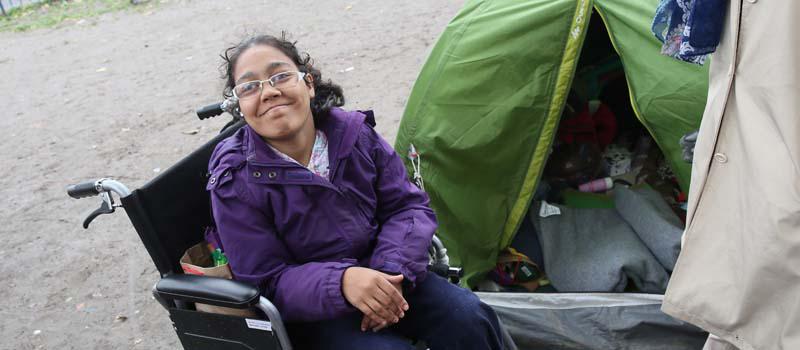Driven by stigma or the urge to protect, families tend to hide those with disabilities. Discrimination and isolation intensifiy the pervasive risk of gender-based violence. By focusing on physical and social inclusion, humanitarians can mitigate this isolation.
Female. Disabled. Displaced. The intersection of these factors increases a woman’s risk of sexual and gender-based violence many times over.
In refugee camps and communities, displaced persons with disabilities are often invisible. Driven by stigma or the urge to protect, families tend to keep those with disabilities sheltered inside. A woman with physical disabilities, alone in her home for long hours, is vulnerable to rape and intimate partner violence. But, because she is socially and physically isolated, nobody knows, and she is unable to access appropriate support and services.
Women and girls – and sometimes men and boys – with intellectual disabilities are especially at risk of sexual violence, abuse and exploitation. Excluded from sexual and reproductive health education, and without protective peer networks in their communities, they are unaware of the risks and may not have learned how to protect themselves.
Humanitarians could mitigate this isolation by inviting refugees with disabilities to participate in programs and by designing these programs to accommodate and include those with physical, intellectual and mental disabilities. But most of the time, humanitarian response ignores the risks of gender-based violence for the 15% of refugees who have disabilities.
Refugees, having survived violence and flight, are among the most resilient people in the world. Turning away from our responsibility to address the gender-based violence needs of the displaced who have disabilities because they are too complicated, is absurd.
But we constantly hear of missed opportunities from women like Sitymayi, from Burundi, who is one of more than 7.5 million persons with disabilities currently displaced. She has a child who was the result of rape, but she says, “When I was pregnant, no one would help me, I gave birth alone…. But I knew that I needed to care for my baby and to find a way to make sure we were both okay.”
It’s not just physical barriers that prevent people with disabilities from accessing programs and services designed to prevent and respond to GBV in humanitarian settings. Discrimination on the part of families, communities and even service providers is the biggest barrier. Conversely, attitudes that support and include refugees with disabilities are the biggest motivators for them to come out of the shadows.
When 16-year-old, wheelchair-bound Nageen Mustafa was interviewed by international media as she made her way through Europe with her family, she captured the hearts of people all over the world, not because she was desperate but because she talked about her desire to become an astronaut and to meet the queen (of England). Having just made the 4,000-mile, 20-day trip by sea and over land from Syria to the Hungarian border in a wheelchair, she laughed as she told reporters that she actually enjoyed her trip because of the adventure.
Nageen taught many of us a lesson about perceptions and assumptions. Perhaps the most important thing we can learn from her is this: if humanitarians don’t know how to assist refugees with disabilities, they should ask them.
* * * *
I See That It Is Possible: Building Capacity for Disability Inclusion in Gender-based Violence (GBV) Programming in Humanitarian Settings (report and toolkit for GBV practitioners)
The Women’s Refugee Commission and International Rescue Committee recently conducted a project to identify barriers to access, and to pilot and evaluate disability inclusion in GBV programs. The participatory research was conducted in conflict-affected communities in Burundi, Ethiopia, Jordan and the Northern Caucasus in the Russian Federation.


